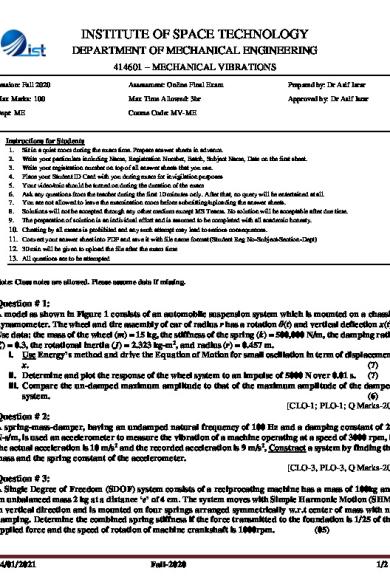* The preview only shows a few pages of manuals at random. You can get the complete content by filling out the form below.
Description
INSTITUTE OF SPACE TECHNOLOGY DEPARTMENT OF MECHANICAL ENGINEERING 414601 – MECHANICAL VIBRATIONS Session: Fall 2020
Assessment: Online Final Exam
Prepared by: Dr Asif Israr
Max Marks: 100
Max Time Allowed: 3hr
Approved by: Dr Asif Israr
Dept: ME
Course Code: MV-ME
Instructions for Students 1. 2. 3. 4. 5. 6. 7. 8. 9.
10. 11. 12. 13.
Sit in a quiet room during the exam time. Prepare answer sheets in advance. Write your particulars including Name, Registration Number, Batch, Subject Name, Date on the first sheet. Write your registration number on top of all answer sheets that you use. Place your Student ID Card with you during exam for invigilation purposes Your video/mic should be turned on during the duration of the exam Ask any questions from the teacher during the first 10 minutes only. After that, no query will be entertained at all. You are not allowed to leave the examination room before submitting/uploading the answer sheets. Solutions will not be accepted through any other medium except MS Teams. No solution will be acceptable after due time. The preparation of solution is an individual effort and is assumed to be completed with all academic honesty. Cheating by all means is prohibited and any such attempt may lead to serious consequences. Convert your answer sheet into PDF and save it with file name format (Student Reg No-Subject-Section-Dept) 30 min will be given to upload the file after the exam time All questions are to be attempted
Note: Class notes are allowed. Please assume data if missing.
Question # 1: A model as shown in Figure 1 consists of an automobile suspension system which is mounted on a chassis dynamometer. The wheel and tire assembly of car of radius r has a rotation θ(t) and vertical deflection x(t). Use data: the mass of the wheel (m) = 15 kg, the stiffness of the spring (k) = 500,000 N/m, the damping ratio (ζ) = 0.3, the rotational inertia (J) = 2.323 kg-m2, and radius (r) = 0.457 m. i. Use Energy’s method and drive the Equation of Motion for small oscillation in term of displacement x. (7) ii. Determine and plot the response of the wheel system to an impulse of 5000 N over 0.01 s. (7) iii. Compare the un-damped maximum amplitude to that of the maximum amplitude of the damped system. (6) [CLO-1; PLO-1; Q Marks-20]
Question # 2: A spring-mass-damper, having an undamped natural frequency of 100 Hz and a damping constant of 20 N-s/m, is used an accelerometer to measure the vibration of a machine operating at a speed of 3000 rpm, if the actual acceleration is 10 m/s2 and the recorded acceleration is 9 m/s2, Constract a system by finding the mass and the spring constant of the accelerometer. [CLO-3, PLO-3, Q Marks-20]
Question # 3: A Single Degree of Freedom (SDOF) system consists of a reciprocating machine has a mass of 100kg and an unbalanced mass 2 kg at a distance ‘e’ of 4 cm. The system moves with Simple Harmonic Motion (SHM) in vertical direction and is mounted on four springs arranged symmetrically w.r.t center of mass with no damping. Determine the combined spring stiffness if the force transmitted to the foundation is 1/25 of the applied force and the speed of rotation of machine crankshaft is 1000rpm. (05)
04/01/2021
Fall-2020
1/2
Now, when the system/machine is actually supported on the springs, it is observed that the damping reduces the amplitude of successive free vibrations by 25%. Determine i. The force transmitted to foundation at 1000rpm (05) ii. The force transmitted to the foundation at resonance, and (05) iii. The amplitude of the forced vibration of the machine at resonance. (05) [Q Marks-20]
Figure 1
Figure 2
Figure 3
Question # 4: Consider the camera and mount system as shown in Figure 2. Model the camera in torsional vibration as shown where JP = 9.817x10-6 m4 and L = 0.2 m. Use the values for the mass (m = 3 kg), shaft length (l = 0.55 m), torque (Mo = 15xL N-m) and frequency (ω = 10 Hz). Here G is the shear modulus of aluminum and the rotational inertia of the camera is approximated by J = mL2. Find out the following: a. The torsional natural frequency, (5) b. The maximum torsional deflection experienced by the camera due to the wind, and (5) c. The linear displacement corresponding to the computed torsional deflection. (4) The same problem was studied in the class in which torsion was ignored. Now here we need to analyze if ignoring the torsion is a reasonable assumption or not. Please comment on this assumption based on the obtained results (Limit imposed on the camera’s vibration requirement of deflection of 0.01 m). (6) [CLO-2, PLO-2, Q Marks-20] Question No. 5: A three degree of freedom spring-mass system is shown in the Figure 3. a. Obtain the Flexibility Influence Co-efficient matrix. (5) b. Use Stodola’s Method and obtain the first natural frequency and modal vector (carry out two iterations), and (5) [CLO-1, PLO-1, Q Marks-05] c. Second natural frequency and model vector by the use of Sweeping technique (carry out three iterations). (5) d. Analyze the system by plotting its mode shapes. (5) [CLO-2, PLO-2, Q Marks-05]
04/01/2021
Fall-2020
2/2

